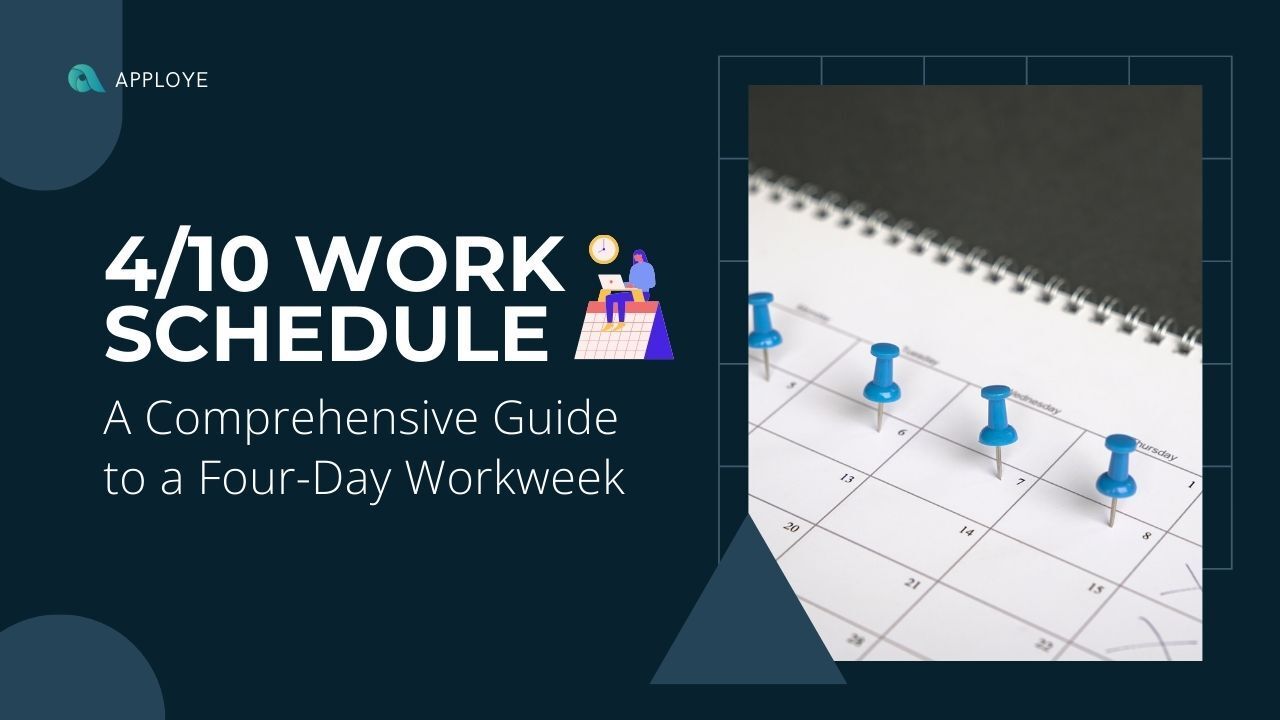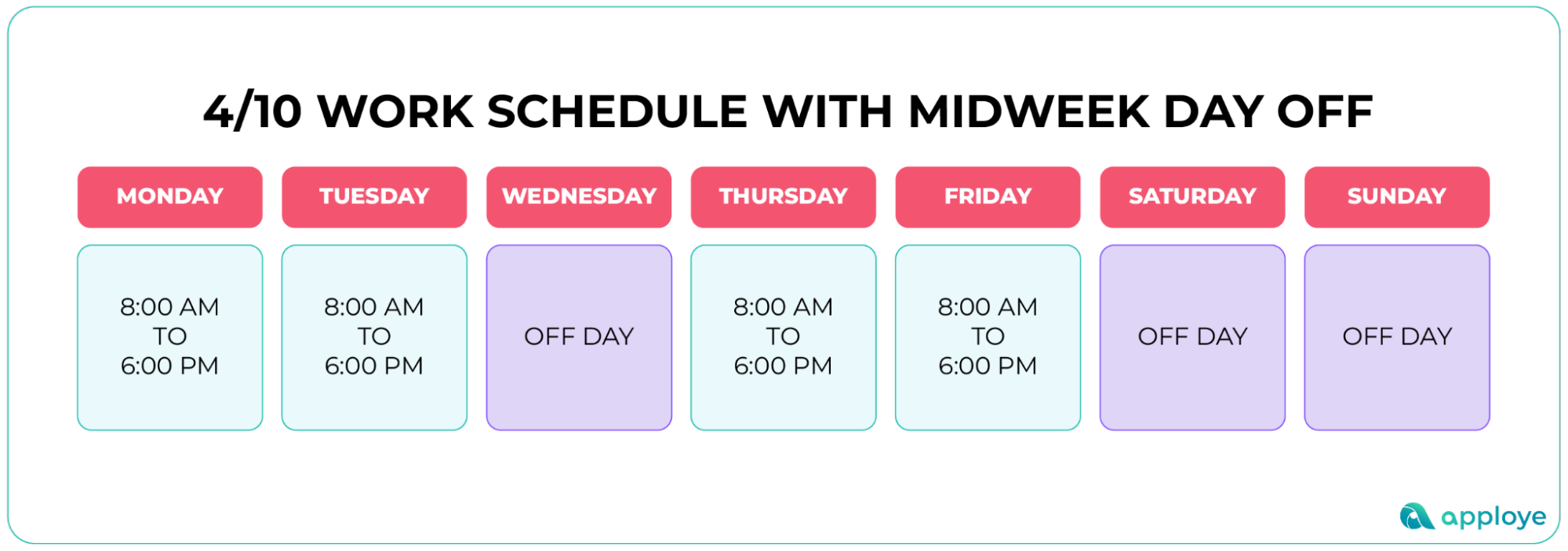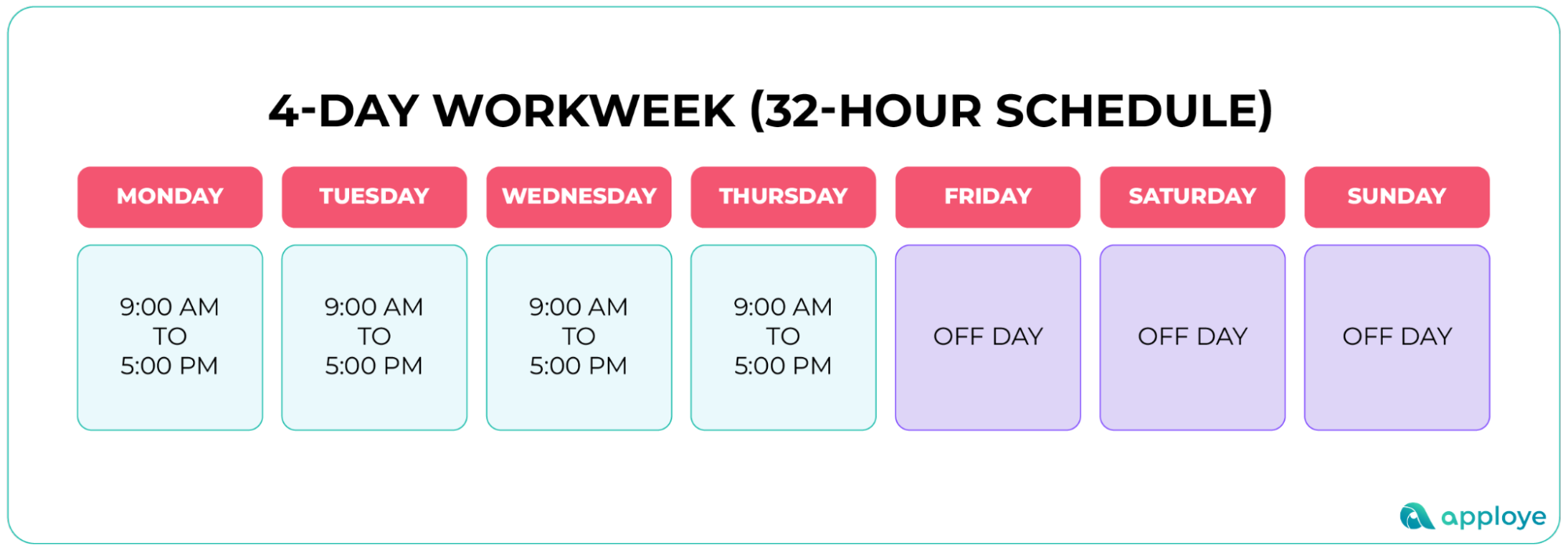4/10 Work Schedule: A Comprehensive Guide to a Four-Day Workweek

In today's fast modern world, people consider innovations in their everyday life. They always look for ways to optimize resource usage and increase outcomes. One creative example is implementing a 4/10 work schedule.
Whether you are an employee or an employer, this work schedule will benefit both. It is time to analyze the structure, the pros and cons, and the implementation mechanisms of this work schedule.
In this article, we will see how you can implement a 4/10 work schedule in your organization to help your employees be more productive and have an improved work-life balance and how your workforce can reshape its workplace.
What is a 4/10 work schedule?
A 4/10 work schedule, commonly referred to as a "four-day workweek" or "compressed work schedule, is defined as a work schedule wherein employees work for 10 hours per day in a span of four working days each week.
That sums up to 40 hours weekly, same as the traditional 5/8 work schedules. It doesn't really change the typical workweek scheme. Thus, you can consider the employees as full-time workers with the same benefits and wages.
This condenses the working days to four days, leaving a three-day weekend each week. The extra day off allows more time to relax, self-care, and personal improvement. Thus the employees can maintain an ideal work-life balance.
4-day workweek schedule examples
Example 1: 4/10 Work Schedule
Structure: Four days a week, ten hours each day.
Schedule:
- Monday: 8:00 AM - 6:00 PM
- Tuesday: 8:00 AM - 6:00 PM
- Wednesday: 8:00 AM - 6:00 PM
- Thursday: 8:00 AM - 6:00 PM
- Friday: Off
- Saturday: Off
- Sunday: Off

Example 2: 4/10 Work Schedule with Midweek Day Off
Structure: Four days a week, ten hours each day, with a midweek break.
Schedule:
- Monday: 8:00 AM - 6:00 PM
- Tuesday: 8:00 AM - 6:00 PM
- Wednesday: Off
- Thursday: 8:00 AM - 6:00 PM
- Friday: 8:00 AM - 6:00 PM
- Saturday: Off
- Sunday: Off

Example 3: 4-Day Workweek (32-Hour Schedule)
Structure: Four days a week, eight hours each day, totaling 32 hours per week.
Schedule:
- Monday: 9:00 AM - 5:00 PM
- Tuesday: 9:00 AM - 5:00 PM
- Wednesday: 9:00 AM - 5:00 PM
- Thursday: 9:00 AM - 5:00 PM
- Friday: Off
- Saturday: Off
- Sunday: Off

Pros and cons of working 4/10 hour days
The Advantages of a 4/10 Work Schedule for Employees
Productivity Improvement
With a 4/10 work schedule, you can get a massive boost in your productivity. It allows you to concentrate more intensely on your work and avoid the mid-week fatigue that sometimes hampers efficiency.
You can accomplish higher quality output in your projects as the extended hours will help you to dive deep into your assignments. Additionally, the long 3-day weekend gives you plenty of time to be relaxed and recharged. It will help you return to your work energized and prepared to take on new challenges with fresh zeal.
Work-life Balance
A 4/10 work schedule offers you a better work-life balance. By condensing your workweek into four days, you can earn an additional day off to spend with family, explore your interests, or relax. This extra day off can ease your stresses, reduce work burnout, and enhance your overall well-being.
Longer weekends allow you more time for leisure activities, which facilitates establishing an equilibrium between work and professional obligations and eventually increases your level of happiness and contentment.
Skill Development
A 4/10 work schedule can help you grow your skills further. With three days off every week, you may dedicate more time to your learning and personal development. This is the perfect time for you to start taking online classes, trending workshops, or conducting your research.
A more flexible schedule helps you to concentrate on learning new things that can advance your career. This continuous learning process will open up new opportunities in your professional career.
The Advantages of a 4/10 Work Schedule for Employers
Lower Absenteeism
By implementing a 4/10 work schedule, you may drastically reduce the absenteeism of your employees. Employees who enjoy a three-day weekend have more time to attend to their personal affairs and recover from illness, thereby reducing the number of unplanned absences.
This improved work-life balance leads to a more positive and healthier working atmosphere. As a result, you will benefit from a workforce that is more reliable and stable, that can guarantee smoother operations, and reduce the interruptions created by frequent absenteeism.
Cost Saving
Implementing a 4/10 work schedule can offer you substantial cost savings for your company. You will save money on your operational costs like utility, maintenance, and office supplies by allowing your employees to work fewer days per week in your office.
Furthermore, this schedule can reduce overtime expenses, as the extended workdays can accommodate lengthier projects to be completed without adding extra expenditures. You can boost your overall profit and foster growth by reinvesting these savings.
Improve Retention Rate
A 4/10 work schedule can greatly increase your employee retention rate. Offering a more flexible and balanced work environment will increase your company's appeal to both current and future employees.
Extended weekends and increased job satisfaction will also increase your workforce's job satisfaction and devotion. By maintaining a positive workplace culture, you can reduce turnover, saving on new recruitment processes and training.
The Disadvantages of 4/10 Work Schedule
Not suitable for all industries
Industries and organizations like healthcare, customer support, retail, etc. that need to provide continuous support can find it challenging to implement a 4/10 work schedule without disrupting their services. In that case, you need to arrange more protections, manpower, and resources for smooth operation.
Longer workdays
Four 10-hour shifts can be exhausting as you need to face longer work hours than the traditional one. This can cause poor results, especially for physical labor and intense concentration. Extended work hours can increase fatigue, inefficiencies, and potentiality, which can affect the quality of work at the end of the day.
Potential for burnout
Despite longer weekends, you can feel exhausted and stressed from working for a long period. It can drain you mentally and physically. This intense work pressure may cause chronic fatigue. Also, your time in workdays can hamper balancing your work and life.
Reduce staff coverage
Because of longer weekends, a 10-hour shift may reduce staff coverage throughout the week. If you can't schedule properly, you can have certain days understaffed, which could impact the operation adversely. Furthermore, not all departments of organizations can avail themselves of the 4/10 hours work schedule, which can cause a conflict among all your employees.
4-10 vs 5-8 work schedule study
As stated above, a 4-10 work schedule compresses your work days, increases the work time to 10 hours, and frees more days in a week. After a ten-hour shift of hard work, it comes a more relaxed period.
On the other hand, the standard 5-8 work schedule, known as 9 to 5 jobs, offers more workdays, fewer working hours, and fewer weekends. But it is more conventional and acceptable to the commoners.
However, to get a clear difference, let's check both work schedules.

Is a 4/10 Work Schedule Right for You?
To determine if a 4/10 work schedule is good for your business, you need to consider factors such as your personal life, job preference, location, and lifestyle. For that, read the above pros and cons of a 4/10 work schedule carefully.
However, it fits best with employees who value longer weekends most. Also, if you have long commutes, choose this schedule to reduce the number of commute days. Again, the nature of the job is a factor to consider.
Before implementing a 4/10 work schedule, an employer should think about the nature of work in his workplace. If the workplace serves for a longer period of a day, then a 4/10 work schedule is a good choice. Healthcare, manufacturing plants, and certain tech sectors are some of its examples.
On the other hand, if your job requires continuous physical labor or if you struggle with fatigue and issues maintaining your energy level, then it might be better for you. Jobs that have a shorter duration of service and require intense focus are not appropriate for a 4/10 work schedule.
Deciding the best work schedule for you requires careful assessment of your personal and professional preferences. Consider the benefits of longer weekends and fewer commutes against the possible downsides of longer workdays, with the risk of more stress and burnout.
You May Also Like:
↘️Popular Work Schedule Types
Implementing a 4/10 Work Schedule
Step 1: Assess Feasibility
First, assess the feasibility of implementing a 4/10 work schedule in your workplace. Consider the nature of work, operational requirements, and other significant elements, as not all jobs may fit with this schedule. If you are confident enough that your job will fit perfectly with this pattern, then go for the second step.
Step 2: Create a Detailed Plan
Outline how you will maintain your operations on a daily as well as weekly basis. Prepare a detailed plan and focus on the implications of this new work schedule for overtime, breaks, and compliance with labor law.
Step 3: Communicate Clearly
Clear communication and the elimination of all confusion are required during this transition. First, provide clear guidance through written circulars or by holding meetings. Address all the employee's queries very carefully and emphasize support during this changeover.
Step 4: Develop a Pilot Program
Design a pilot program and collect feedback on this new system's performance and shortfalls. In this pilot program, engage only a small group of your employees for assessment.
Step 5: Monitor and Evaluate
Monitor the progress very carefully. Collect necessary data on employee productivity, operational challenges, etc. Evaluate the overall performance. Tools like Apploye can be the best fit to automate this step.
Step 6: Gather Feedback
After completing the predetermined period of your pilot program, gather feedback from your employee as well as from other stakeholders (if possible) involved in this pilot program. Consider the comments and suggestions from all parties.
Step 7: Adjust and Expand
Based on the evaluation and feedback, redesign and modify your work plan as necessary. Then, gradually expand this schedule to other sectors of your workplace.
Step 8: Review and Refine
Periodically collect reviews from stakeholders and continue your internal monitoring and evaluation. Be open to suggestions and feedback. Make necessary adjustments, and finally, after a few cycles, you will reach a state to finalize your organization's policies.
FAQ
Is a 10-Hour Workday Too Long?
It depends on the type of job, mostly whether it is a physical or mental workload. Also, it is about individual capability and personal preferences. Some individuals may find an extra workload difficult for their productivity and can get stressed and experience burnout.
On the other hand, others may find it beneficial due to an extra day off as they can utilize it for their leisure and personal matters. Along with that, commute time between the workplace and residence is another important factor. If the commute time is long, then 10 hours of work a day can be stressful.
Who is the 4/10 Work Schedule for?
A 4/10 work schedule is suitable for employees who prefer longer weekends or want an extra day off during the week to spend with family or with their interests. This work schedule might be advantageous for the workplace where continuous service is required.
For example, hospitals, international customer services, manufacturing industries, etc. Those workplaces run almost 24 hours a day, seven days a week at a stretch, and they have shifting employees. They may think of this work schedule. It will provide better management and great outcomes in their operations. However, it might not be suitable for a role that requires shorter work time in a day with intense work pressure.
How Popular is the 4/10 Work Schedule?
The 4/10 work schedule is getting popular day by day due to its pattern of more relaxing days in a week. Also, employers find it suitable to attract employees. As this work schedule is highly dependent on the pattern of work, the widespread adaptation of this schedule over the conventional 5/8 work schedule is not happening.
Some countries adopt more innovative work patterns to maximize their productivity. With the rise of remote work, it is again getting popular to facilitate better work-life balance. However, this work schedule is still evolving and remains on the list of some innovative work schedule patterns explored by modern workplaces.
What are some companies Using a 4/10 Work Schedule?
Several renowned companies in the world have adopted a 4/10 work schedule in their workplace. It may not be a large-scale implementation, but it fits the specific parts of their workplace.
Some examples are Microsoft, PepsiCo, Shake Shack, Treehouse, Basecamp, Best Buy, Deloitte, Perkins Coie LLP, REI, Urban Outfitters, etc.
Final words
The 4/10 work schedule adds a new extension to the modern work dynamics. For proactive people who want to utilize their time in a more structured and productive, this 4x10 shift offers the master plan to grow in both their career and personal development.
However, it is essential to recognize if it fits you and your organization. The 4/10 work schedule is expected to be the future gizmo for shaping a more balanced and productive workforce.
Related Articles:
